跨文化交际课程教案-对应教案资料-浙江大学出版,主编-郑晓泉
- 格式:doc
- 大小:195.20 KB
- 文档页数:38
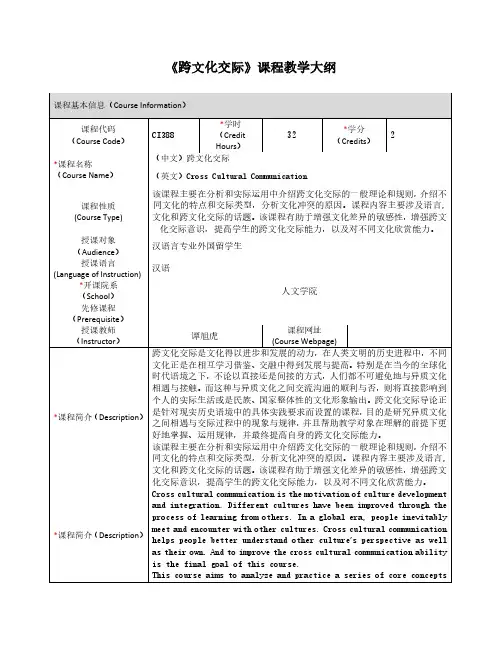
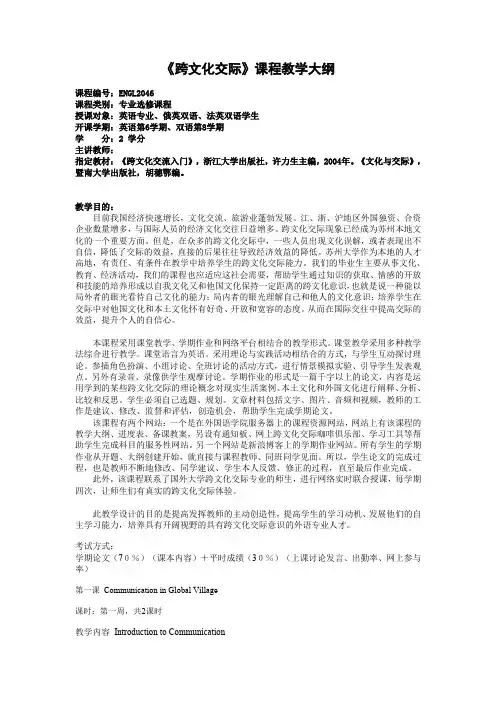
《跨文化交际》课程教学大纲课程编号:ENGL2046课程类别:专业选修课程授课对象:英语专业、俄英双语、法英双语学生开课学期:英语第6学期、双语第8学期学分:2 学分主讲教师:指定教材:《跨文化交流入门》,浙江大学出版社,许力生主编,2004年。
《文化与交际》,暨南大学出版社,胡穗鄂编。
教学目的:目前我国经济快速增长,文化交流、旅游业蓬勃发展。
江、浙、沪地区外国独资、合资企业数量增多,与国际人员的经济文化交往日益增多。
跨文化交际现象已经成为苏州本地文化的一个重要方面。
但是,在众多的跨文化交际中,一些人员出现文化误解,或者表现出不自信,降低了交际的效益,直接的后果往往导致经济效益的降低。
苏州大学作为本地的人才高地,有责任、有条件在教学中培养学生的跨文化交际能力。
我们的毕业生主要从事文化、教育、经济活动,我们的课程也应适应这社会需要,帮助学生通过知识的获取、情感的开放和技能的培养形成以自我文化又和他国文化保持一定距离的跨文化意识,也就是说一种能以局外者的眼光看待自己文化的能力;局内者的眼光理解自己和他人的文化意识;培养学生在交际中对他国文化和本土文化怀有好奇、开放和宽容的态度。
从而在国际交往中提高交际的效益,提升个人的自信心。
本课程采用课堂教学、学期作业和网络平台相结合的教学形式。
课堂教学采用多种教学法综合进行教学。
课堂语言为英语。
采用理论与实践活动相结合的方式,与学生互动探讨理论。
参插角色扮演、小组讨论、全班讨论的活动方式,进行情景模拟实验、引导学生发表观点。
另外有录音、录像供学生观摩讨论。
学期作业的形式是一篇千字以上的论文,内容是运用学到的某些跨文化交际的理论概念对现实生活案例、本土文化和外国文化进行阐释、分析、比较和反思。
学生必须自己选题、规划。
文章材料包括文字、图片、音频和视频,教师的工作是建议、修改、监督和评估,创造机会,帮助学生完成学期论文。
该课程有两个网站:一个是在外国语学院服务器上的课程资源网站,网站上有该课程的教学大纲、进度表、备课教案,另设有通知板、网上跨文化交际咖啡俱乐部、学习工具等帮助学生完成科目的服务性网站。
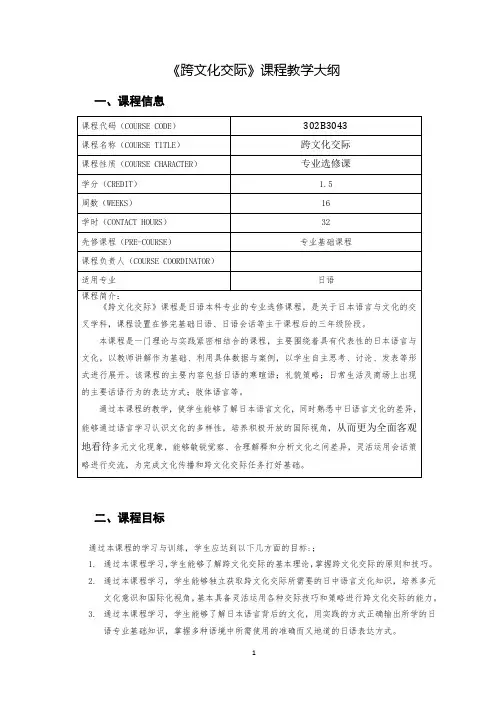
《跨文化交际》课程教学大纲
一、课程信息
二、课程目标
通过本课程的学习与训练,学生应达到以下几方面的目标:;
1.通过本课程学习,学生能够了解跨文化交际的基本理论,掌握跨文化交际的原则和技巧。
2.通过本课程学习,学生能够独立获取跨文化交际所需要的日中语言文化知识,培养多元
文化意识和国际化视角,基本具备灵活运用各种交际技巧和策略进行跨文化交际的能力。
3.通过本课程学习,学生能够了解日本语言背后的文化,用实践的方式正确输出所学的日
语专业基础知识,掌握多种语境中所需使用的准确而又地道的日语表达方式。
4.通过本课程学习,学生能够了解跨文化交际所需要的中日文化知识,培养中日语言文化
对比能力,提高实际语言运用能力和交际应变能力。
课程目标对毕业要求的支撑关系表
三、教学内容与预期学习成效
3
4
5
6
四、成绩评定及考核方式
7
8
五、课程建议教材及主要参考资料
1.建议教材
1. 张韶岩(编).中日跨文化交际实用教材华东理工大学出版社,2012年
2.主要参考书
1. 滝浦真人. ポライトネス入門研究社出版,2008年
2. 周平、陈小芬. 新编日语 1、2册(重排版),上海外语教育出版社,2016年
9。

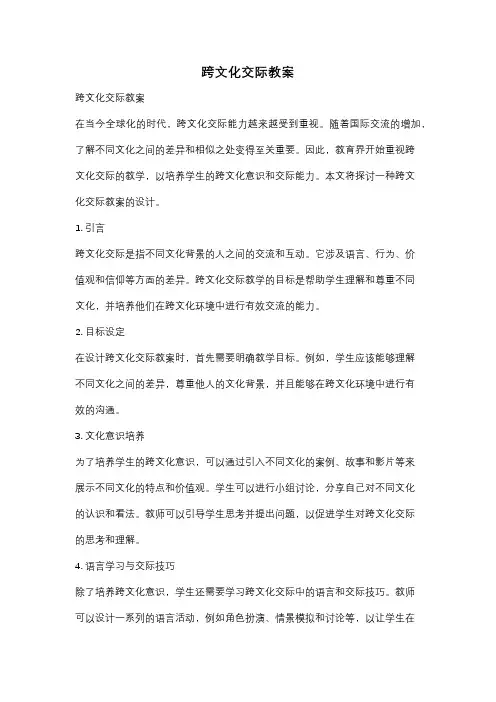
跨文化交际教案跨文化交际教案在当今全球化的时代,跨文化交际能力越来越受到重视。
随着国际交流的增加,了解不同文化之间的差异和相似之处变得至关重要。
因此,教育界开始重视跨文化交际的教学,以培养学生的跨文化意识和交际能力。
本文将探讨一种跨文化交际教案的设计。
1. 引言跨文化交际是指不同文化背景的人之间的交流和互动。
它涉及语言、行为、价值观和信仰等方面的差异。
跨文化交际教学的目标是帮助学生理解和尊重不同文化,并培养他们在跨文化环境中进行有效交流的能力。
2. 目标设定在设计跨文化交际教案时,首先需要明确教学目标。
例如,学生应该能够理解不同文化之间的差异,尊重他人的文化背景,并且能够在跨文化环境中进行有效的沟通。
3. 文化意识培养为了培养学生的跨文化意识,可以通过引入不同文化的案例、故事和影片等来展示不同文化的特点和价值观。
学生可以进行小组讨论,分享自己对不同文化的认识和看法。
教师可以引导学生思考并提出问题,以促进学生对跨文化交际的思考和理解。
4. 语言学习与交际技巧除了培养跨文化意识,学生还需要学习跨文化交际中的语言和交际技巧。
教师可以设计一系列的语言活动,例如角色扮演、情景模拟和讨论等,以让学生在真实的交际情境中练习语言表达和交际技巧。
此外,教师还可以引导学生学习一些文化特定的礼仪和习俗,以帮助他们更好地适应不同文化环境。
5. 跨文化交际实践为了让学生能够真正应用所学的跨文化交际技能,教师可以组织一些实践活动。
例如,学生可以参观当地的跨文化社区或组织,与不同文化背景的人进行交流。
他们还可以参加国际交流项目,与来自其他国家的学生进行合作和交流。
通过这些实践活动,学生将有机会亲身体验和应用所学的跨文化交际技能。
6. 评估与反馈在教学过程中,教师应该定期评估学生的跨文化交际能力,并提供及时的反馈。
评估可以包括口头和书面的方式,例如学生的表现、作业和考试等。
通过评估和反馈,教师可以了解学生的进展情况,并根据需要进行教学调整和改进。

跨⽂化交际教案跨⽂化交际教案教学时间:第1周教学内容:Unit 1: Introduction to Cross-Cultural CommunicationCommunication, Essential Elements of Communication教学重点:What is communication?教学难点:What are essential elements of communication?教案笔记:1. Discovering Characteristics of CommunicationCommunication is the medium for instruction, assessment, interpersonal relationships, group interactions, parent and community relations and counseling. Most behavior problems in schools, and their resolutions, involve some type of communication. In sum, communication permeates education.Theoretically, the model of communication is always described in the following2. Communication is culture bound.The way an individual communicates emanates from his or her culture. Of course, a person may know more than one culture or may be competent in a combination of cultures. Nonetheless, one basic truth prevails: communication is a product of culture.3. Discovering Characteristics of Other CulturesAs you begin to discover the characteristics of other cultures, remember that cultures vary internally and are changeable. There are usually many cultural differences within a single race or nationality.4. Culture, Communication and LanguageThe concept of communicative competence, based on one's knowledge of the rules of language structure and language use within a given culture, will be useful.A major responsibility of teachers at all grade levels is to teach the language and communication skills needed for academic success, and for career and social mobility.The study of sociolinguistics can help us understand different systems as a means of improving the quality of our instruction in language and the communication arts.5. Cultural Differences in DiscourseDiscourse rules govern such aspects of communication as:1.Opening or closing conversations;2.Taking turns during conversations;3.Interrupting;/doc/0426a3970029bd64793e2c2c.html ing silence as a communicative device;5.Knowing appropriate topics of conversation;6.Interjecting humor at appropriate times;/doc/0426a3970029bd64793e2c2c.html ing nonverbal behavior;8.Expressing laughter as a communicative device;9.Knowing the appropriate amount of speech to be used by participants; and10.Sequencing of elements during discourse.教学时间:第2周教学内容:Unit 1: Introduction to Cross-Cultural CommunicationCross-Cultural Communication, Case Study教学重点:What is Cross-Cultural Communication?教学难点:the attributes of culture教案笔记:A. Communication has its own attributes:1.It is born need. People need communication or they will be driven crazy.2.It is interactive. No communication can be done by oneself alone.3.It can be either constructive or destructive to a relation. Just review a recentconversation you had then they can prove this.4.It cannot be whitewashed in c ase it is performed. You may say, ―Sorry, I didn‘tmean that.‖ But your counterpart has heard what you had said and would not be likely to forget it.B. In practice we should also know that the essential elements of communication:1.There should be at least two parties;2.There should be information-to-exchange, or a message;3.There should be a contact between the two parties;4.There should be a language (human language or artificial ones) that both sides canshare;5.There should be a place for the communication to take place;6.There should be a time for the communication to take place.C. If you were Thompson‘s tutor, what would you do with his question? Reference: Chinese equivalent for ―communication‖沟通,通信,通讯,交通,交际,交流D. In international business cross-cultural communication, the definition of culture can be ranged in three-step hierarchy: Spiritual: such as beliefs, core of values, ethnics;Custom: such as manners, organizations, techniques;Material: such as food, tools, clothing.E. From the hierarchy we may draw the attributes of culture:1)It is learnt, not obtained from genes. Take Junior Huang, a Chinese boy, born andbrought up in the USA for example: unlike his mom and dad who came to the USA after graduation from university and worked for some years in China, Junior Huang doesn‘t care the conformity with others. He insists that he show his specialty while his parents get a bit worry about that as they have been told since they were young kids that the failure in keeping conformity would lead to displeasing the people around and face-losing. Junior Huang was encouraged byhis friends and teachers that he should value his own individuality, and the information he gets from TV and other media is also in this tone. So, bearing a great resemblance to his parents) dark skin, black hair, flat nose, etc.), junior Huang acts just the same to any of his American peers.2)It is shared by a group of people. If we say it is a culture, we mean it is observedby a lot of people in a certain group. So when we advice our oversea teams to get adapted to local culture, we mean they should watch what and how most local people do and then try to get used to that.3)It is symbolic. Even knowing not any Japanese, one can tell the friendly welcomeby the bows a Japanese person makes, while in most other parts of the world that can be shown by an offer of handshake. A designed pattern on a plate can be read as a suggestion of the origin whether from Arabic countries or China. Many can be of symbols of a culture --- language, (verbal or non-verbal one), architects, arts, and so on.4)It is adaptive. No culture is fixed except the dead ones. A culture has to evolve asthe people in the culture have to develop. In China, people used to greet with kowtow (磕头), and then a raise of the crossed-hands (拱⼿), but now most Chinese business people prefer a handshake with a ―你好‖ as their counterparts in most parts of the world. The booming of KFC (Kentucky Fried Chicken) worldwide is also a good illustration.F. Explanation:In Chinese culture, it is customary to please a parent by making compliment on his kids, for girl praise of appearance or features, for boy praise of smartness. The patting or teasing of an adult to a youngster is usually taken as a sign of caring or friendliness.While in Western culture, neither is approved especially the latter, which is even a taboo.Without knowing the difference in different cultures, the scholar may have thought that her friendliness was wrongly taken so she was astonished and annoyed before she knew the reason.G. Key Points:What may effect cross-cultural communication?Cross-cultural communication, or intercultural communication, is communication among people from different cultures. In cross-cultural communication, one should keep in mind some basic elements that effect the communication:1) The Ways that people observe things(⼈们观察事物的⽅法)2) Verbal language3) Non-verbal language教学时间:第3周教学内容:Unit 2: Social InteractionHow to make introduction; How to deal with business cards教学难点:教案笔记:1. Discovering Characteristics of Other CulturesWhen teachers ask "How can I learn about culture X?", all too often teachers are discouraged to learn that there is no comprehensive book (or list) available on culture X. The lack of reading matter on various cultures is, in some ways, a blessing, since knowledge of other cultures is better acquired by experience than by study. Thus, teachers should plan to experience cultures different from their own, particularly the cultures represented in their schools and classrooms. To be valid, these experiences should incorporate a few basic principles and discovery techniques.2. How to make introductionTo avoid feeling socially awkward and to present a poised, polished, and professional image upon meeting and makingintroductions, here are eight guidelines to follow:1.Introduce people in business based on rank, not gender or age.2.In business, the client, guest or visitor outranks the boss or co-worker and shouldbe introduced first.3.Women and men should stand when introduced. Always smile and maintain eyecontact.4.Shake a woman and man's hand the same, straight up and down. Extend a good,firm (not painful) handshake to exhibit respect, trust, and acceptance.5.Keep the forms of address equal to avoid differential treatment or the appearanceof preferential treatment.6.Never use an honorific such as Ms., Mr., or Dr. to introduce yourself.7.Demonstrate professionalism and credibility by clearly stating your full name.8.Do not call a person by his or her first name when meeting or being introducedfor the first time. Use their title and last name until invited to be on a first-name basis.3. Tips of etiquettes: Comparing the above two situations, you may find something similar. That is the way to make introduction in business field, while it is somewhat different from social etiquette:1.Present the host to the visitor (or young to the senior);2.Senior positioned is presented first;3.If some introduced are on the same position, usually the senior aged first.4. Introduction Games: As a matter of fact, this difference lies also between most Eastern Asian languages and most Western languages. The difference stems in different cultures.Most Eastern Asian countries are regarded as the chopsticks-zoned nations. While in most Western countries, people are encouraged to treat others equally regardless of their positions and deeds.5. Handshake is as popular as the dollar. In business encounter, handshake is always acceptable no matter how different the cultures of the people are.教学时间:第4周Unit 2: Social InteractionWhat to say for small chat教学重点:教学难点:教案笔记:1. Deal with Business CardsThe content of a business card includes: company you work for, name, business title, and contacting ways. Arabic, German and some Eastern Asian cultures prefer to get academic degrees included as well. Business titles may be confusing to people from other cultures, so consider using a translation that can portray your job or position in words or concepts more familiar to your counterparts. Example:2. Hints:1.You have left out some information that has nothing to do with your business(the title: Vice-chairman of Wuhan Children-Caring Association and Member of Hubei Calligraphy Society).2.You have added some information that can make business contact easier (thetelephone number of your company, the name of your country).3.You have got some information simplified (your position and profession).4. Some tips for dealing with business cards:1)Translate your card into the local languages if you are somewhere outside yourcountry.2)Wait to be introduced before presenting your card.3)Present your card with the printed side up. In case of bilingual cards, with thelocal language side showing.4)Give your card to the highest-ranking individual or leader of the visitingdelegation first, especially when they are from Japan or Korea, as this is a sign of respect and can avoid embarrassing the inferior-ranking ones.5)Use your both hands to take a card from your Japanese contact, but never use theleft hand if your contact is from Islamic culture.6)Read it once more after receiving a card, as this is a sign of respect. On the otherhand, if you happen to have some troubles (we do often) remembering of the foreign names, reading the card can help a great deal.5. What to say for small chatIn Asian countries, people often use kin terms in their conversation.In Western countries, people do not use kin terms so extensively as their counterparts in Eastern Asia. They even address their uncle or aunt with just the first name. One of the reasons for this is that they believe in equality very much that they may think born relation need n‘t be emphasized; otherwise, there will be a gap between people. Age is also a reason. People in Western countries don‘t like to be thought old. Addresses of most kin terms may remind them of being aging. They also would like to be addressed with the first name as that shows acceptance or friendliness.6. Different titles for addressingInternational business activities usually cannot do away with the different values in different cultures. In certain societies, individual is not valued very much and an individual‘s value is decided by his position in the group belongs to. This cultural trait is acknowledged as Collectivism. Most nations in the Eastern Asia and the South-Eastern Asia are of collectivist cultures, while some societies value individual very highly regardless of his/her position and his/her virtue. This culture is labeled as Individualism. A lot of Western nations are of individualist culture.教学时间:第5周教学内容:Unit 3: Culture and Language in InteractionThe relation of culture and sociolinguistics, Cultural differences教学重点:教学难点:教案笔记:1. Culture and SociolinguisticsSince communication is the interaction of people in the society, the social culture influences the communication greatly. Andthe culture also influences students‘ language skills and their learning of Standard English, the language of education.2. SociolinguisticsSociolinguists examine social and cultural influences on language behavior. Among the most important concepts to emerge are those relating to dialects and language standards.Sociolinguists have documented the presence of dialects in every language.For a variety of reasons, including negative public attitudes and inadequate teaching models, nonstandard English speakers often do not effectively learn Standard English in school.3. Cultural Differences in DiscourseThese topic centered stories are characterized by tightly structured sentences that reflect on a single or small set of highly related topics. The speaker presumes little shared knowledge with listeners. Topic centered stories, therefore, tend to be very explicit and contain great detail, emphasizing more telling than showing. Topic centered stories are thought by some to be associated with the field independent cognitive style. I4. Examples of Cultural and Communicative TendenciesIn this section, we will present examples of cultural and communicative tendencies observable among African American and white students from several cultural groups in the United States. Tendencies are not universal. In order to avoid generalizations and stereotypes about cultural groups, variations within cultures must always be considered. Highly educated people of a given cultural group are less likely to reveal indigenous language and communication patterns than less educated persons. Moreover, many people communicate in ways influenced by other cultures.5. The Significance of Culture Based Communicative Behavior in SchoolA variety of cross cultural communication problems can arise in school, and it is important that teachers not automatically blame the student or the student's family or culture. Problems often result from misunderstandings or value conflicts between teachers and students who are obeying different culturally based communication rules. Some common problems linked to cultural and communicative diversity are presented in Table V教学时间:第6周教学内容:Unit 3: Culture and Language in InteractionEntertainment in the interactions, make a disagreement pleasant教学重点:教学难点:教案笔记:In social interaction, culture and language are very important in communication. It is more obvious in commercial or business interaction.A. To form a social situation, there should be:1.at least two participants;2.an aim;3. a setting;4.schema for fulfill the aim;5.verbal or non-verbal communication;6.time and space.B. It is heard but it isn‘t taken in the way it is uttered.A communication starts from a source of information and ends in the retrieval of information. In a social situation, theparticipants can play the both roles of the source and the retrieval and they can also interpret the other side‘s message in their own way. It means the utterance meaning of the source may not be fully taken as the source side expects.Now we can see in interaction, good wish doesn‘t always lead to a good result. In cross-cultural business communication, we should know about the different values, different observations and customs of our counterparts and try to monitor the social situation in a way we expect or are oriented.C. Ms. Karat is checking the gift parcels for a group of visitors from a Japanese organization partner. Lowell is helping her. After finishing reading their conversation, try to decide which of the following statements are true:1.The gifts for the group of Japanese visitors are not the same.2.If one of the visitors found his gift were the same to that of his director, he wouldfeel grateful and satisfied.3.For Japanese visitors, whisky can never be used as gift.4.An efficient secretary keeps the record of the gift distributed.Gift distributing is a quite frequent practice in business contacts.Anyhow, not all nice looking and nice-wish-carrying gifts are really taken as nice things by all people.Nowadays, more and more organizations prefer to have their gifts customized.Gifts can also help you to draw potential partners, customers and so benefits.The last but not the least is that though refusing a gift is fairly rare in international business circles, in North American and European culture, company policy states that an employee of tank, is not allowed to receive a gift of any size.D. Other polite ways for decliningHow are Western people? Are they very direct in refusal making? John‘s story may indicate what stalling technique (⽀吾的技巧) is employed in saying ―no‖without saying the word of ―NO‖.教学时间:第7周教学内容:Unit 4 Gender CommunicationCommunication Modes between Males and Females教学重点:教学难点:教案笔记:A. Gender differences---including how men and women talk and view life---can generate misunderstanding and even hostility at work and in family relationships.One of the keys to improving communication between men and women and people with different personality or cultural styles is to check the semantics of the words being used when disagreements arise.Another key to improving communication is to not always expect the worst of others. As Miller's Law put: "In order to understand what another person is saying, you must assume that it is true and try to imagine what it could be true of."Often we come into conversations with preconceived notions about other people. One of our goals is to break down some of those preconceived notions so when something happens, we can get past the irritability and realize that although we're different, we're after the same thing---effective communication.B. Gender Communication Differences and StrategiesWhat can your organization do to create more equality for men and women? The first step to creating equality is to understand the different strengths and styles that different genders bring to the work table. Oftentimes men and women use different processes for decision making and leadership. Here are some common ways that men and women differ:1. Attitude towards tasks vs. relationships.2. Way of Processing Information.3. Leadership Style.4. Communication Styles.5. Talk time.C. Men take up more time and space at meetings, while women try to make sure thereis more equality in the room. Despite stereotypes to the contrary studies have shown that men talk more then women. Men interrupt women and talk over them much more that women interrupt men. All of this can lead to the type of miscommunication based on assumptions of why member of the other sex are using certain verbal and non-verbal behaviors. These miscommunications can result in team breakdown, people not listening to each other and loss of good ideas.D. How different styles lead to workplace disparity(差别)1. That there is only one style or way to lead and that is the more hierarchical one.2. That most women can't be leaders because they are not "strategic."3. Because many of these men are married to women who work in the home, they have a hardertime conceiving of women running organizations, and therefore are not as objective when making hiring and promotion decisions.4. There is an unconscious belief that women are not in the workforce on a permanent basis anddon't really want to move up or stay.教学时间:第8周教学内容:Unit 4 Gender CommunicationStrategies in gender communication, Roles females play in business教学重点:教学难点:教案笔记:A. Strategies to Bridge Gender Differences and Value Diverse StylesIf you grasp the importance of effective gender communications and gender equality in the workplace, then start making a difference today using the following gender communication strategies.1. Take these facts with a grain of salt. It's important not to use this information to stereotype all men or all women.2. Stay aware. Both men and women need to be aware of each others styles of communication both verbal and non-verbal in order to avoid miscommunication and work better together.3. Be aware of unconscious stereotypes and biases and be open to breaking past them in order to leverage each others strengths.4. Recognize that many different styles of leadership can be effective.5. Men, be aware of how much time and space in meetings or group interaction.6. Women, get comfortable asserting more space for yourself.7. Finally, Get Information. Learn about male and female styles of communication and be able to use both.B. The attachment of sub-cultures to their main culture can be diagramed like this:C.Males and females are treated differently since the early stage of their life.D. Now, you may have a clear idea about what do gender roles mean: the expected ways of behaving for a male or female according to a society.The conclusion may be reached like these:1.Gender roles are socially created.2.Gender roles are classified into three types:A.Masculine →dominant, aggressive. Administrators, executive managers,firemen, etc. are taken for granted to be males.B.Feminine →passive, nurturing. Nurses, shop assistants, kindergartencaretakers are thought to be female s‘ occupations.C.Androgynous → a mixture of masculine and feminine. Tom-boy is one of thecase here.3.Gender identity usually involves a certain combination of correspondencebetween sexual feature and gender role in the society, so it is cultured rather than merely born with nature.E. Taking into consideration the present situation, here are some tips for career ladies to be as competent as their male counterparts:1)Work professionally.2)Dress properly (no mini-skirt in the office, no too high the heel in working, no oddhairstyle, etc.).3)Be serious at work (no talking with the male colleagues about the topic unrelatedto work, no chat on phone about trifle things with friend at work time, etc.).4)Never be late for work and never leave earlier without excuse.5)No gossiping with other people in the office.6)Find a suitable way to outlet stress.教学时间:第9周教学内容:Unit 5 Body Language & Non-Verbal CommunicationBody language, Difference between non-verbal & verbal communication教学重点:教学难点:教案笔记:A. Most people believe the best way of communication is verbal. However, oral communication makes up just 10 percent (or less) of the total means to get across a message.B. Most people don't mean what they say!C. The Body Always Tells The Truth!D. Learn how to identify emotions like anger, boredom, nervousness, doubt, openness, uncertainty, disappointment, or enthusiasm by viewing facial expressions, gestures,and postures.You can leverage bodies' language knowledge to discover whether confidence, supremacy, and other traits can be found in people. Alternatively, you can execute these movements when you desire to communicate particular personality traits to influence others subconsciously. Terrific, isn't it?Once you have read this section, you never will view the world in the same manner again. You'll have the ability to instantly adjust particular actions to any situation. It will be very easy to communicate with others. You will develop a much better insight about people. It is as though you are seeing things afresh.E. Non-verbal CommunicationSome signals are probably common to all of us.All the signals I have mentioned so far can be controlled.F. Body language is the reason why selling face-to-face has a huge advantage over selling by phone.Our body language will give others an impression of ourselves or show our emotions. You're probably using it right now to read this article (you will either be alert and interested, or baffled and un-interested).教学时间:第10周教学内容:Unit 5 Body Language & Non-Verbal CommunicationDescription of some facial expressions, ways to improve body language教学重点:教学难点:教案笔记:A. "an important aspect of Posture running a successful business"Our body language is an important aspect of running a successful business as we cannot always say what we really feel. This means we have to act positive in negative situations (and vice-versa of course). You can also identify other people's body language and know what they really mean: whatever they may be sayingB. "If you are sitting, you can still give an image of power"If you are sitting, you can still give an image of power. If standing isn't appropriate, use more space by stretching your legs out or by having your arms at the side of the chair. When you are on the phone and you need to be assertive, standing up will project your urgency.Hand-to-Face MovementsGesturesC. "we are attracted to those people who are similar to ourselves"Another gesture that we use is called 'mirroring'.A more common gesture is perhaps the one that is most annoying.Grooming gestures are those things we do to reassure ourselves.Facial ExpressionEye ContactD. "Making little eye contact can say that the other person doesn't like you"Body language comes in many forms. Different people have their own ability to recognize body language and they will recognize it with different meanings to other people. So, when you use body language, one person may see it differently to the other.教学时间:第11周教学内容:Unit 6 Cultural ConflictionCauses of cultural confliction, Improve relationships by CCC教学重点:What is Cultural Confliction?教学难点:High-Context --- Low-Context Cultural Pattern教案笔记:The confliction between Western and Eastern cultures is rooted mainly in four basic cultural patterns:A.Collectivist --- Individualist Cultural PatternIn individual cultures, each individual is an equally important part of the social structure, and each individual is valued for his/her unique role in the society.In collective cultures, on the other hand, all individuals are very loyal to the groups they are part of, and usually make choices about marriage, education, and work together with their families or other people in the same group.High-Context --- Low-Context Cultural PatternLow-context communication is like a computer grogram; everything must be specified in the coded message or the computer program will not run. In a low-context culture like the United States, individuals must express themselves as explicitly as possible for effective communication to occur.High-context communication, in contrast, is like communication between twins who were raised together. It is noticed that twins intuitively understand each other and use shortened sentences and words when they talk. To ensure efficient communication with people from high-context cultures, one has to keep a sharp eye on all the verbal and ono-verbal signs, because they use understatement and hints and body language to put over their message.B.High-power Distances and Low-Power Distances Cultural PatternHigh-power distances cultures believe that authority is essential in social structure, and strict social classes and hierarchy exist in these cultures. It means that people who have more power and who have higher positions are treated more formally than other people.In low-power distances cultures people believe in equality and the people with power may interact with thee people without power on an equal level. That is to say all people should be treated equally regardless of their positions and authority in the society. So administration is in many‘s hands.C.Monochronic time --- Polichronic time Cultural Pattern(1) Different cultures value time in different types.(2) In communication, monochronic time attaches importance with working on timetable.(3) In a lot of monochronic cultured countries, such as the Netherlands, Scandinavia and Germany, working life and private life are kept separate and only in unusual circumstances do they expect to talk business outside working hours or in non-work environment.。
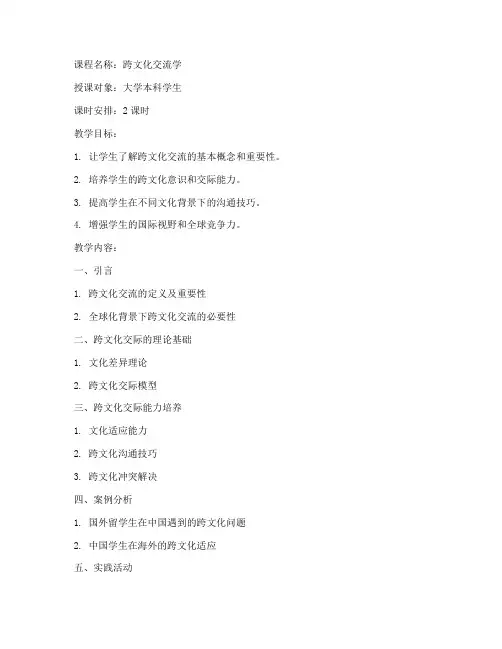
课程名称:跨文化交流学授课对象:大学本科学生课时安排:2课时教学目标:1. 让学生了解跨文化交流的基本概念和重要性。
2. 培养学生的跨文化意识和交际能力。
3. 提高学生在不同文化背景下的沟通技巧。
4. 增强学生的国际视野和全球竞争力。
教学内容:一、引言1. 跨文化交流的定义及重要性2. 全球化背景下跨文化交流的必要性二、跨文化交际的理论基础1. 文化差异理论2. 跨文化交际模型三、跨文化交际能力培养1. 文化适应能力2. 跨文化沟通技巧3. 跨文化冲突解决四、案例分析1. 国外留学生在中国遇到的跨文化问题2. 中国学生在海外的跨文化适应五、实践活动2. 跨文化交际情景模拟教学过程:第一课时:一、导入1. 提问:同学们,什么是跨文化交流?为什么跨文化交流如此重要?2. 引导学生思考:全球化背景下,跨文化交流对我们有什么影响?二、讲解跨文化交流的定义及重要性1. 跨文化交流的定义2. 跨文化交流的重要性三、介绍跨文化交际的理论基础1. 文化差异理论2. 跨文化交际模型四、案例分析1. 国外留学生在中国遇到的跨文化问题2. 中国学生在海外的跨文化适应第二课时:一、讲解跨文化交际能力培养1. 文化适应能力2. 跨文化沟通技巧3. 跨文化冲突解决二、实践活动1. 跨文化交际角色扮演三、总结1. 回顾本节课的主要内容2. 强调跨文化交流能力的重要性3. 布置课后作业:思考如何将所学知识应用于实际生活中教学评价:1. 学生对跨文化交流的定义和重要性有了更深入的理解。
2. 学生能够运用跨文化交际的理论基础分析实际问题。
3. 学生在实践活动中的表现,体现了跨文化交际能力的提升。
课后作业:1. 针对所学的跨文化交际技巧,思考如何将其应用于实际生活中。
2. 收集关于跨文化交流的案例,撰写一篇短文,分析案例中的跨文化问题及解决方法。
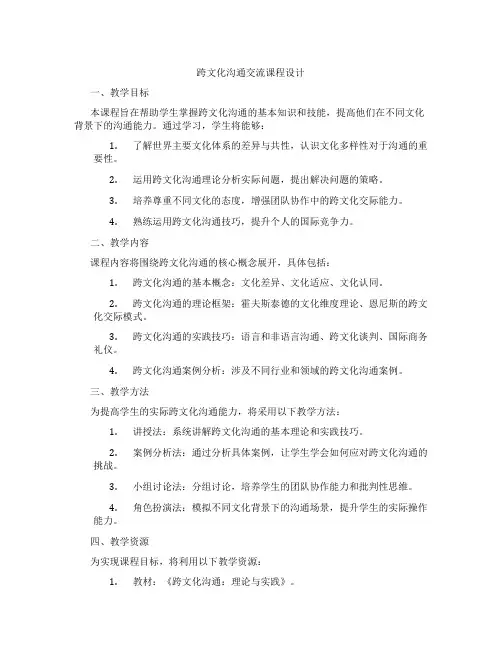
跨文化沟通交流课程设计一、教学目标本课程旨在帮助学生掌握跨文化沟通的基本知识和技能,提高他们在不同文化背景下的沟通能力。
通过学习,学生将能够:1.了解世界主要文化体系的差异与共性,认识文化多样性对于沟通的重要性。
2.运用跨文化沟通理论分析实际问题,提出解决问题的策略。
3.培养尊重不同文化的态度,增强团队协作中的跨文化交际能力。
4.熟练运用跨文化沟通技巧,提升个人的国际竞争力。
二、教学内容课程内容将围绕跨文化沟通的核心概念展开,具体包括:1.跨文化沟通的基本概念:文化差异、文化适应、文化认同。
2.跨文化沟通的理论框架:霍夫斯泰德的文化维度理论、恩尼斯的跨文化交际模式。
3.跨文化沟通的实践技巧:语言和非语言沟通、跨文化谈判、国际商务礼仪。
4.跨文化沟通案例分析:涉及不同行业和领域的跨文化沟通案例。
三、教学方法为提高学生的实际跨文化沟通能力,将采用以下教学方法:1.讲授法:系统讲解跨文化沟通的基本理论和实践技巧。
2.案例分析法:通过分析具体案例,让学生学会如何应对跨文化沟通的挑战。
3.小组讨论法:分组讨论,培养学生的团队协作能力和批判性思维。
4.角色扮演法:模拟不同文化背景下的沟通场景,提升学生的实际操作能力。
四、教学资源为实现课程目标,将利用以下教学资源:1.教材:《跨文化沟通:理论与实践》。
2.参考书籍:提供相关领域的经典和最新著作,供学生深入阅读。
3.多媒体资料:收集相关的视频、音频和网络资源,丰富教学手段。
4.实验设备:如需的话,安排实验室练习,让学生在实践中学习跨文化沟通。
五、教学评估为全面评估学生的学习成果,本课程将采用以下评估方式:1.平时表现:通过课堂参与、提问和小组讨论等方式,评估学生的积极性和主动性。
2.作业:布置相关的写作和研究报告,评估学生对课程内容的理解和应用能力。
3.考试:期末进行闭卷考试,评估学生对跨文化沟通知识的掌握程度。
4.跨文化沟通能力展示:学生进行角色扮演或案例分析展示,评估他们的实际沟通能力。
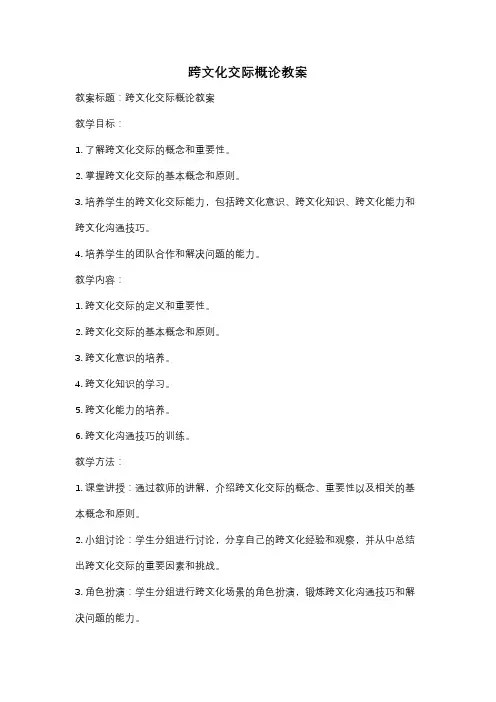
跨文化交际概论教案教案标题:跨文化交际概论教案教学目标:1. 了解跨文化交际的概念和重要性。
2. 掌握跨文化交际的基本概念和原则。
3. 培养学生的跨文化交际能力,包括跨文化意识、跨文化知识、跨文化能力和跨文化沟通技巧。
4. 培养学生的团队合作和解决问题的能力。
教学内容:1. 跨文化交际的定义和重要性。
2. 跨文化交际的基本概念和原则。
3. 跨文化意识的培养。
4. 跨文化知识的学习。
5. 跨文化能力的培养。
6. 跨文化沟通技巧的训练。
教学方法:1. 课堂讲授:通过教师的讲解,介绍跨文化交际的概念、重要性以及相关的基本概念和原则。
2. 小组讨论:学生分组进行讨论,分享自己的跨文化经验和观察,并从中总结出跨文化交际的重要因素和挑战。
3. 角色扮演:学生分组进行跨文化场景的角色扮演,锻炼跨文化沟通技巧和解决问题的能力。
4. 案例分析:通过分析真实的跨文化案例,让学生理解跨文化交际中可能出现的问题,并提出解决方案。
5. 多媒体展示:使用多媒体资料,展示不同文化之间的差异和交流方式,帮助学生更好地理解和认知跨文化交际。
教学资源:1. 教科书:选择一本关于跨文化交际的教材,作为教学指导。
2. 多媒体资料:准备一些关于不同文化之间交流的视频和图片,用于课堂展示。
3. 案例材料:收集一些真实的跨文化案例,用于学生分析和讨论。
评估方法:1. 学生小组讨论的成果:评估学生在小组讨论中的参与度和贡献度。
2. 角色扮演表现:评估学生在角色扮演中展示的跨文化沟通技巧和解决问题的能力。
3. 案例分析报告:评估学生对跨文化案例的分析能力和解决问题的能力。
4. 期末考试:设计一份包括选择题、填空题和简答题的考试,测试学生对跨文化交际概论的理解和掌握程度。
教学进度安排:本教案建议将跨文化交际概论课程分为10个教学小时进行教学,具体进度安排如下:- 第一课时:引入跨文化交际概念和重要性(课堂讲授)- 第二课时:跨文化交际的基本概念和原则(课堂讲授)- 第三课时:跨文化意识的培养(小组讨论)- 第四课时:跨文化知识的学习(课堂讲授+多媒体展示)- 第五课时:跨文化能力的培养(角色扮演)- 第六课时:跨文化沟通技巧的训练(课堂讲授+案例分析)- 第七课时:复习和总结(课堂讲授)- 第八课时:学生小组讨论和准备案例分析报告- 第九课时:学生案例分析报告展示和讨论- 第十课时:期末考试以上是一个基本的教案框架,具体的教学内容和方法可以根据教师的实际情况和学生的需求进行调整和补充。

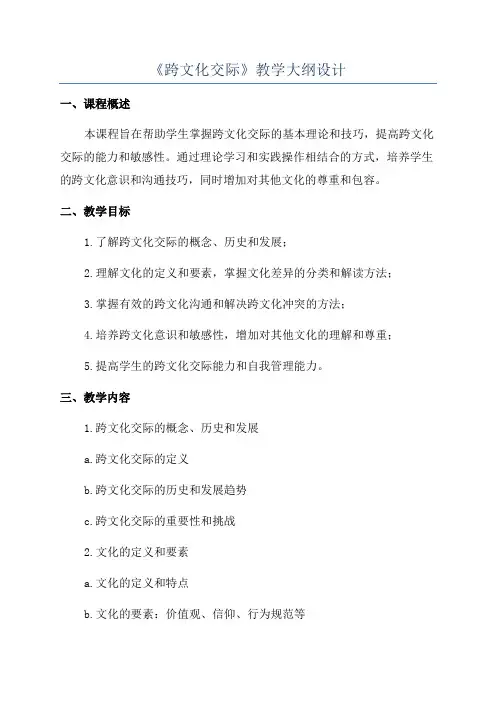
《跨文化交际》教学大纲设计一、课程概述本课程旨在帮助学生掌握跨文化交际的基本理论和技巧,提高跨文化交际的能力和敏感性。
通过理论学习和实践操作相结合的方式,培养学生的跨文化意识和沟通技巧,同时增加对其他文化的尊重和包容。
二、教学目标1.了解跨文化交际的概念、历史和发展;2.理解文化的定义和要素,掌握文化差异的分类和解读方法;3.掌握有效的跨文化沟通和解决跨文化冲突的方法;4.培养跨文化意识和敏感性,增加对其他文化的理解和尊重;5.提高学生的跨文化交际能力和自我管理能力。
三、教学内容1.跨文化交际的概念、历史和发展a.跨文化交际的定义b.跨文化交际的历史和发展趋势c.跨文化交际的重要性和挑战2.文化的定义和要素a.文化的定义和特点b.文化的要素:价值观、信仰、行为规范等c.文化因素对交际行为的影响3.跨文化差异的分类和解读方法a.地理文化差异:气候、地理环境等b.社会文化差异:宗教、价值观念、社会制度等c.非语言文化差异:肢体语言、面部表情、目光接触等d.解读跨文化差异的方法和技巧4.跨文化沟通的方法a.语言和交流方式的适应性b.姿态和守则:尊重、礼貌、包容、灵活c.解决跨文化冲突的方法:倾听、理解、互动5.跨文化意识和敏感性的培养a.增加对他人文化的理解和尊重b.提高对自身文化的反思和认知c.跨文化体验的重要性和方法6.跨文化交际的案例分析和实践操作a.跨文化交际的挑战和困惑b.跨文化交际的成功案例和实践经验分享c.跨文化交际能力的评估和提升四、教学方法1.授课讲授:概念、理论的讲解和分析2.小组讨论:案例分析、问题研讨3.视频观摩:真实场景的跨文化交际实例观看和讨论4.角色扮演:模拟跨文化交际场景,进行实践操作5.跨文化体验活动:参观文化场所、参与文化节庆等五、教学评估1.平时作业:课堂讨论、小组报告、课后阅读和思考题2.期中考试:对课程知识和理论的检测。
跨文化交际教案教案标题:跨文化交际教学教学目标:1. 初步了解跨文化交际的概念和重要性。
2. 掌握跨文化交际的基本技巧和策略。
3. 培养学生的跨文化意识和尊重不同文化的能力。
教学内容:1. 跨文化交际的概念和重要性。
2. 跨文化交际的基本技巧和策略。
3. 跨文化意识与尊重不同文化。
教学步骤:步骤一:导入(5分钟)教师通过提问和讲解的方式引入课题,让学生思考跨文化交际的概念和重要性。
步骤二:概念讲解(10分钟)教师简要讲解跨文化交际的概念和定义,并介绍跨文化交际在现实生活中的重要性。
可以通过实际案例和统计数据等方式加深学生对概念的理解和认识。
步骤三:技巧和策略讲解(15分钟)教师介绍跨文化交际的一些基本技巧和策略,如尊重对方文化、注重非语言沟通、避免刻板印象等。
同时,教师可以通过示范和练习活动的方式让学生学习和运用这些技巧和策略。
步骤四:讨论和分享(15分钟)学生分组讨论跨文化交际中可能出现的问题和挑战,并分享自己的观点和经验。
教师可以引导学生思考如何解决这些问题和应对挑战的策略。
步骤五:跨文化意识培养(15分钟)教师通过讲解和讨论的方式培养学生的跨文化意识和尊重不同文化的能力。
可以通过引导学生关注和了解不同文化的习俗、价值观和信仰等,以及如何与来自不同文化背景的人建立和谐的关系。
步骤六:小结和总结(10分钟)教师对今天的教学内容进行小结和总结,回顾学生所学的知识和技能,并与学生共同总结出跨文化交际的核心要点和实用技巧。
教学资源:1. 多媒体投影仪或黑板、粉笔等。
2. 多媒体课件或教学PPT。
3. 实际案例和统计数据。
教学评估:教师可以通过观察学生的讨论和分享,以及课堂练习和小组活动的表现来评估学生的学习情况和掌握程度。
此外,可以设计一些问答题或小作文让学生进行书面评估,以检测他们对跨文化交际知识的理解和应用能力。
跨文化交际课程教学大纲一、课程简介跨文化交际是指在多文化背景下进行有效沟通和合作的能力。
跨文化交际课程旨在培养学生在不同文化背景下的适应能力、理解能力和沟通技巧。
通过本课程的学习,学生将能够更好地跨越语言和文化的障碍,增进国际间的理解与友谊。
二、课程目标本课程的主要目标是帮助学生:1.了解不同文化之间的差异和相似之处;2.掌握跨文化交际的基本原则和技巧;3.培养与不同文化背景的人沟通与合作的能力;4.增进对其他文化的尊重、欣赏和理解。
三、教学内容本课程将涵盖以下主题:1.文化概论a) 文化的定义和特点b) 文化对个人和社会的影响c) 多元文化主义的概念和重要性2.文化差异与文化冲突a) 文化差异的原因和表现形式b) 不同文化之间的冲突和误解c) 跨文化冲突的解决方法3.跨文化交际的基本原则a) 尊重他人的文化和价值观b) 适应不同的礼节和行为准则c) 理解和应对文化差异4.误解和歧视a) 语言和行为的误解b) 非理性的偏见和歧视c) 打破误解和歧视的方法和策略5.跨文化交际的实践a) 跨文化团队合作b) 跨文化销售与市场营销c) 跨文化外交与国际关系四、教学方法本课程将采用多种教学方法,以促进学生的参与和互动。
主要教学方法包括:1.讲授:教师通过讲解理论和案例,介绍跨文化交际的基本知识和技巧;2.案例分析:通过分析真实的跨文化交际案例,让学生理解其中存在的文化差异和问题;3.讨论:通过小组讨论和全班讨论的形式,促进学生对跨文化交际问题的思考和理解;4.角色扮演:通过角色扮演的方式,让学生亲身体验跨文化交际中可能遇到的情境,并提供解决问题的实践机会;5.案例研究:学生将选择一个真实的跨文化案例,并进行深入的研究和分析,以展示他们的学习成果。
五、评估方式本课程的评估方式将包括以下几个方面:1.平时表现:包括出勤情况、参与度和小组合作等;2.课堂作业:包括阅读理解、写作和案例分析等;3.个人报告:学生需选择一个跨文化交际案例,进行深入研究和报告;4.期末考试:综合考察学生对跨文化交际原理和技巧的理解和运用能力。
《大学英语跨文化交际》课程教案IntroductionI. 主要内容作者在本章阐述了全球化概念,文化融合和跨文化交际的相关概念。
首先,从经济学和社会学等视角把握全球化的概念,了解全球化对文化多样性的影响。
同时,论述了全球化的历史起源,阐述了现代化等概念。
在这一部分里,作者还分析了全球化的形成要素。
其次,在文化融合方面,作者从三个方面阐述了这个问题。
第一,文化多样性的论述。
介绍了在全球化过程中涌现出来的几个概念:世界文化,宏观文化和微观文化。
第二,劳动力多样性的阐述。
第三部分是关于文化多样性的弊端。
最后,作者论述了跨文化交际的相关问题。
充分论证了跨文化交际的概念,研究跨文化交际的必要性和进行有效跨文化交际的关键策略,以及跨文化培训的相关问题,从而形成理解文化差异的能力。
II. Teaching Objectives1.to identify the definitions of globalization, culture merge and intercultural communication2.to identify some relevant concepts about these three main themes3.to cultivate students to be able to recognize and analyze cultural factorsIII. Teaching Course1. Present the Cultural Phenomena to Students(1) Present some cases involving different cultural contacts between persons from different countries or different parts of the same country(2) Then lead to the concept of globalization2. Warm-up Questions1) Do you want to go abroad? What’s your aim?2) Do you find whether it’s easy or not to get along with foreign friends?3. Key terms0.1.1.a. Globalization (from economic standpoint) (从经济学角度定义全球化): It is conceived as a process of increasing involvement in international business operations. (经济学视角中的全球化表现为不断增加的国际商务往来过程)。
跨文化交际 课程教案(对应教材是:浙江大学出版社,郑晓泉主编) 授课题目:Unit 1 Understanding Culture and Intercultural Communication
教学时数: 8学时 授课类型: ■ 理论、实践课 教学目的、要求: 1. To get a general idea of the concepts of “culture”, “cultural difference”, “communication” and “intercultural communication”; 2. To understand the meaning of intercultural communication, its history of the development. 3. To raise students’ awareness of the importance of politeness and appropriateness in intercultural communication.
教学重点: 1. The meaning of intercultural communication, its history of the development. 2. T he importance of politeness and appropriateness in intercultural communication. 3. T he concepts of “culture.
教学难点: The concepts of “culture”. 教学方法和手段:
主要采用交际法,任务法和讲授法的结合,既重视形式和结构,更要重视内容和功能,培养学生的能力要兼顾语言形式、结构及语言表达的内容 与功能。在具体教学方法上不拘一格,,. 灵活多样。
交际练习主要为引导学生分role-play和presentation等活动达到练习的目的; 整体把握上结合使用归纳法和演绎法,既可在归纳中演绎,又可在演绎 之后再归纳;坚持教师为主导,学生为主体,充分调动学生学习的积极性和主动性。
参考资料: 1. CCTV “希望英语”节目. 2.《跨文化交际》, 顾曰国,外语教学与研究出版社,1997年. 3. 《跨文化商务沟通案例教程》,庄恩平,上海外语教育出版社,2004.
教学内容及过程 旁批 ,. 教学内容与教学设计: Teaching Procedures: I. Warm-up Questions Human beings draw close to one another by their common nature, but habits and customs keep them apart. Studying a second language without learning the culture is like learning how to drive a car by studying a driver’s manual and never getting behind a steering wheel. 1. Ask the students to read the above two proverbs and try to guess who said them. 2. Have them think over the question What conclusions do you draw from the above two proverbs?. II. Pre-reading 1. Have the students read the reading material. 2. Ask them to find out the main points. 3. Ask them to list the cultural differences in it. 4. Let them think over the question what is culture?. III. What is culture? 1. Ask the students to find out the different meanings of culture in the form of presentation. 2. Discuss how people get to learn culture. ,.
3. Discuss how to confront different culture, and what right
attitudes are. 4. Summarize the characteristics of culture: Culture is holistic Culture is coherent Culture is constantly changeable Culture is learned and acquired Culture is shared and transmitted Culture ranks what is important Cultures furnishes attitudes Culture dictates how to behave 5. Ask them to provide a example for each of the above characteristic. 6. Study the essence of culture shock. 7. Discuss the characteristics of each stage of culture shock.
IV. Case for Practice Case 1 Read the material and present your idea to the classmates: 1. What remarks made by Wang shortly after Lisa’s arrival seemed to surprise her? How did she react? 2. Did Lisa think the meal unusual? Case 2 ,. Discuss the reading material and present the opinion of your group
to the others.
V. Further reading 1. Read and discuss what is individualism and collectivism? Is their definition different from that of China? 2. Analyze the importance and implications of culture and context.
VI. Intercultural Communication 1. Analyze the word formation intercultural. 2. Ask the students what their first feelings are about intercultural communication. 3. Summarize the elements that affect intercultural communication. 4. Master the ways that help us to become intercultural. 5. Have them practice Case 1 and Case 2 and present their understanding.
VII. Assignments: 1. Ex (pp. 22- 24) 2. Understand the main points of culture completely.
补充资料 International Business Etiquette and Manners :Appearance ,. Business suit and tie are appropriate in all major cities. Wear dark colored
business suits in classic colors of gray and navy. For an important formal meeting, choose a white dress shirt, for less formal a light blue shirt will still give you a conservative appearance. Women should wear a suit or dress with jacket in major cities. Wearing classic clothing and classic colors of navy, gray, ivory, and white will ensure you give a confident and conservative appearance. Rural areas and areas with extremely warm summers have more informal wardrobe requirements. Women may wear a business dress, or skirt and blouse, in rural areas. Men may conduct business without wearing a jacket and/or tie in rural areas. The formality of a meeting, even in rural areas, may dictate a sports jacket and tie for men. The same formality will require a woman to wear a dress, possibly with a jacket. Casual clothing is appropriate when not attending a work related meeting/dinner. Building a casual wardrobe using classic lines and colors (navy, gray, camel, ivory and white) will give you a look that is stylish and professional even when you are relaxing. Clothing, whether formal or casual, should be clean and neat in appearance. Men may generally wear jeans or khaki pants with a shirt for casual attire.